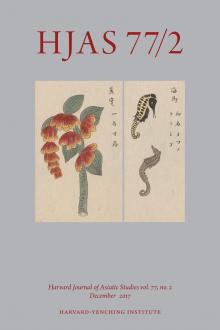December 2017
Tamura Ransui, Chūzan bussankō, 3 vols. (kan) [ca. 1769], vol. 2 (seq. 29, seq. 44); MS no. TJ 3468/6441, Rare Book Collection, Harvard-Yenching Library, Harvard University, Cambridge MA, http://nrs.harvard.edu/urn-3:FHCL:32692219. Photo: Imaging Department © President and Fellows of Harvard College.
Editorial Preface
Articles
An Ever-Expanding Pharmacy
Zhao Xuemin and the Conditions for New Knowledge in Eighteenth-Century China
Bencao gangmu shiyi (Supplement to Systematic Materia Medica) has been recognized as the most outstanding sequel to the sixteenth-century encyclopedia Bencao gangmu, adding over nine hundred drugs to Li Shizhen’s magnum opus. In this article, I investigate the key conditions that rendered it possible for its author, Zhao Xuemin (fl. 1753–1803), to access the textual, empirical, and material resources necessary to accomplish such a feat. I argue that despite Zhao’s efforts to frame his work in a classical light, his humble status as a sojourning private secretary in fact enabled him to derive new knowledge from both elite and lowbrow circles. Zhao and his interlocutors represent an expanding, if oft-neglected community of knowledge, who embraced literary documentation of contemporary experience as a way of transcending the accomplishments of previous authorities. Their existence signifies the beginning of a transition from a literati-dominated culture toward mass society.
本文探讨清代赵学敏著《本草纲目拾遗》成书的历史条件。作为流寓幕客的赵学敏在交游中接触到多样的文献与实物资料,不断修订自己的手稿。这部本草书凭记载当下经验而超越前人经典,亦预示着由士人主导的中国传统文化在十八世纪向近代大众社会的转型。
Monuments and Mandalas in Medieval Kyoto
Reading Buddhist Kingship in the Urban Plan of Ashikaga Yoshimitsu
Kyoto’s urban landscape was transformed during the late fourteenth century through the ambitious building projects of the shogun Ashikaga Yoshimitsu (1358–1408). By examining these projects, I identify a grand urban vision indicative of monumental aspirations. The creation of palaces and temples helped Yoshimitsu infiltrate and eventually dominate warrior, imperial, and religious spheres of influence in Kyoto. More important, the findings suggest the shogun leveraged the allusive power of architecture and urban planning to forge an anthropocosmic connection between himself and the divine. I suggest that Yoshimitsu—like his counterparts in the premodern Buddhist centers of Angkor, Bagan, and Borobudur—sought to transform Japan’s medieval capital into an expression of sacred geography, thereby legitimizing the Kyoto court at a time of imperial schism and advancing his own aim of attaining a status synonymous with dharma king.
中世京都における足利義満の大規模な建造プロジェクトを検討し、建築と王権、および新たな都市構想を分析する。更に、東南アジアの仏教王国との比較を通じ、義満が法皇を目指し、仏教的コスモロジーに基づいて京都の都市計画を行った可能性を提案する。
Mandarin over Manchu
Court-Sponsored Qing Lexicography and Its Subversion in Korea and Japan
The Manchu language studies of the Qing empire emerged in Beijing during the late seventeenth century and spread to Chosŏn Korea and Tokugawa Japan during the eighteenth century. The Qing court sponsored the compilation of multilingual thesauri and thereby created an imperial linguistic order with Manchu at the center and vernacular Chinese, or Mandarin, in a subordinate position. Chosŏn and Tokugawa scholars, by contrast, usually placed Mandarin—not Manchu, Korean, or Japanese—as the leading language in the new multilingual thesauri they compiled on the basis of Qing works. I show how the balance between Manchu and Mandarin changed as Korean and Japanese scholars reworked lexicographic books from Beijing. The lexicographic evidence demonstrates that the international languages of pre-twentieth-century East Asia included Manchu and vernacular Mandarin as well as literary Chinese.
本文以乾隆『御製增訂清文鑑』為例,探討清朝構造的以滿文為中心的多語言制度及其在朝鮮和日本的傳播和轉變。日本和朝鮮學者利用滿語辭書所載的漢語白話譯文與官話注音來學習漢語。漢語對學習滿文必不可少,於是日朝學者往往把辭書中的漢語白話部分作為研究的對象。
Arendt in Asia
Responsibility and Judgment in Nanjing and Hiroshima
Political theorist Hannah Arendt (1906–1975) wrote little on Asia, but her 1963 Eichmann in Jerusalem: A Report on the Banality of Evil suggests how she might have evaluated responsibility for and judgment of war crimes in East Asia. I speculate first about how she might have regarded the 1946–1948 International Military Tribunal for the Far East, and I argue that she would have approved of the executions of those ruled culpable for the Rape of Nanjing while contesting much of the moral and legal thinking that led to them. Second, Arendt’s endorsement of the literary imagination as a tool for judgment allows us to read Hotta Yoshie’s 1963 A-bomb novel Judgment to explore how justice might have been served in the wake of the wartime use of nuclear weapons.
ナチス·ドイツによるユダヤ人虐殺の犯罪責任を再考察した「イエルサレムのアイヒマン」著者のハンナ·アーレント氏ならば、南京虐殺及び原爆投下をいかに裁いたであろう?東京裁判の記録や堀田善衛の小説「審判」にアーレント思想を適用し、その法律的、倫理的な諸問題を解いてみる。
